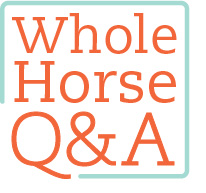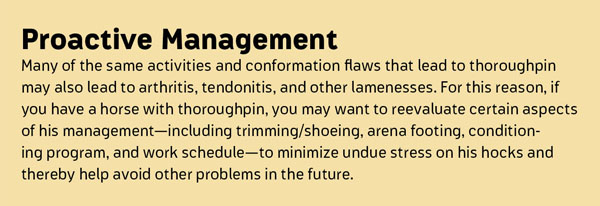Q My 10-year-old part-Arabian gelding appears to have a large thoroughpin in the web of his hock. It gives him no discomfort and isn’t warm to the touch. Is it caused by a conformation flaw or an injury? Can anything be done for it?
[READ ABOUT: Capped Hocks]

KRIS CARBERRY, California
A Thoroughpin is a cosmetic blemish of the hock involving distention of the tarsal sheath of the deep digital flexor tendon just above the hock. It’s characterized by fluid, typically located on the inside of the hock, that courses up and down the leg in the direction of the tarsal sheath. This fluid may also be visible and palpable from the outside of the hock. Thoroughpin is distinguished from bog spavin, the latter being a fluid filling in the hock joint itself.
Thoroughpin usually affects only one leg, varies in size, and is typically of unknown origin. Not accompanied by heat or pain, it generally doesn’t cause lameness, though it can become a chronic condition and is considered a blemish.

The swelling is officially referred to as a “tenosynovitis of idiopathic (unknown) origin,” although traumatic causes can include damage to the deep digital flexor tendon or hock bones next to the tendon from a blow, or from penetrating injuries or blood-born infections. Any horse with poor conformation in the hock region may be at risk for developing thoroughpin. In addition, a horse in heavy work may also be at risk due to the extra stress on his legs.
Arrange for a lameness exam and imaging of the leg to rule out other conditions (such as bog spavin or capped hock) that may cause your gelding to have a swollen hock. Radiographs can reveal changes in joints and bones near the tendon sheath of the deep digital flexor tendon; ultrasound can reveal changes in soft tissues such as tendons and ligaments.
Generally no treatment is necessary or recommended for routine cases of thoroughpin. Treatment can, however, include withdrawal of the fluid and injection of hyaluronate and/or a long-acting corticosteroid; these procedures may need to be repeated until the swelling does not recur. Pressure bandaging the hock following injection may help further reduce the fluid swelling and prevent recurrence.
The prognosis for horses with thoroughpin varies, depending on possible underlying causes. Horses with idiopathic thoroughpin (again, unknown origin) have an excellent prognosis except for the cosmetic blemish. Horses with small damage to the bones surrounding the tendon sheath can also do well, provided damage to the deep digital flexor tendon is minimal.
R. REID HANSON, DVM, DACVS
Professor of Equine Surgery
and Emergency Critical Care
Auburn University
College of Veterinary Medicine






